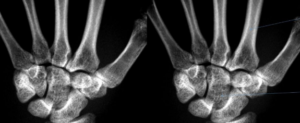How Quantum Algorithms Can Improve X-ray Imaging Processing
Quantum computing is revolutionizing numerous fields, and medical imaging is no exception. X-ray imaging, a critical tool in diagnostics and research, stands to benefit significantly from quantum algorithms. This blog explores how quantum algorithms can enhance X-ray imaging by improving image reconstruction, segmentation, and overall processing efficiency.
The Role of Quantum Algorithms in X-ray Imaging
Quantum algorithms leverage the principles of quantum mechanics to perform computations that are exponentially faster and more accurate than classical methods. In X-ray imaging, these algorithms can address longstanding challenges such as noise reduction, artifact correction, and efficient data analysis.
Key Benefits:
-
Enhanced Image Reconstruction: Quantum optimization algorithms, such as Quadratic Unconstrained Binary Optimization (QUBO), can reconstruct highly accurate CT images by minimizing discrepancies between experimental and computed sinograms. This method reduces errors caused by motion artifacts or insufficient projection data.
-
Improved Segmentation: Advanced quantum algorithms enable direct segmentation from X-ray projection data without requiring intermediate reconstruction steps. This eliminates errors introduced during traditional multi-step processes.
-
Faster Processing: Quantum Fourier transforms and phase estimation algorithms accelerate image reconstruction tasks, reducing scan times and improving patient comfort
-
Reduced Radiation Exposure: Quantum imaging techniques using correlated photon pairs allow for high-resolution imaging with lower radiation doses, making the process safer for patients
Applications in Medical Imaging
Quantum algorithms are particularly promising in medical imaging fields like computed tomography (CT) and magnetic resonance imaging (MRI). Below are specific applications:
| Feature | Classical Methods | Quantum Algorithms |
|---|---|---|
| Image Reconstruction | Susceptible to artifacts and noise | Resistant to artifacts; highly accurate |
| Segmentation | Requires multi-step processes prone to errors | Direct segmentation minimizes errors |
| Processing Speed | Limited by computational power | Exponentially faster processing |
| Radiation Dose | Higher exposure for clear images | Lower doses with quantum correlation imaging |
Challenges and Future Directions
While the potential of quantum algorithms in X-ray imaging is immense, practical implementation remains challenging due to:
-
Limited availability of quantum hardware.
-
High costs associated with quantum systems.
-
Need for more research to refine algorithms for real-world applications.
Despite these hurdles, advancements in quantum technology are paving the way for its integration into medical imaging. Researchers are optimistic that quantum computing will transform diagnostics by providing faster, safer, and more accurate imaging solutions.
Conclusion
Quantum algorithms offer a groundbreaking approach to improving X-ray imaging processing. By enhancing image reconstruction accuracy, segmentation efficiency, and reducing radiation exposure, they promise better outcomes for patients and researchers alike. As quantum computing continues to evolve, its impact on medical imaging will undoubtedly grow, heralding a new era of precision medicine.

Also Read :
